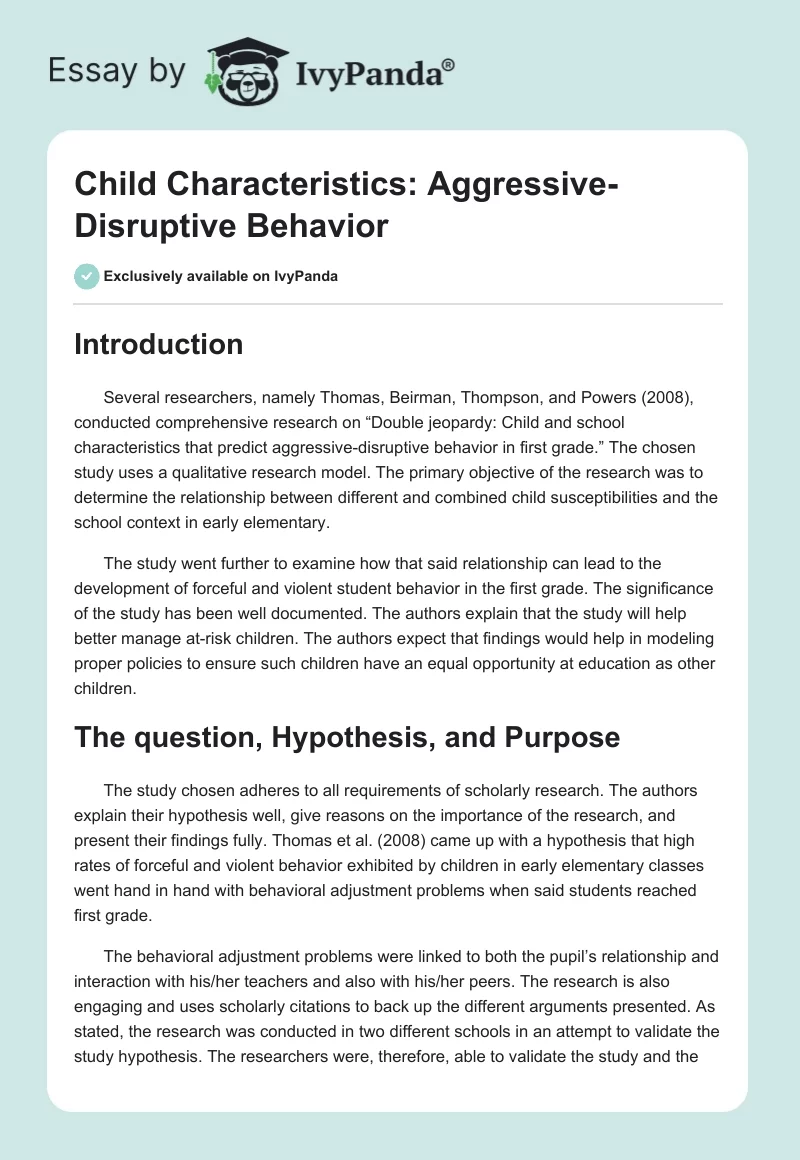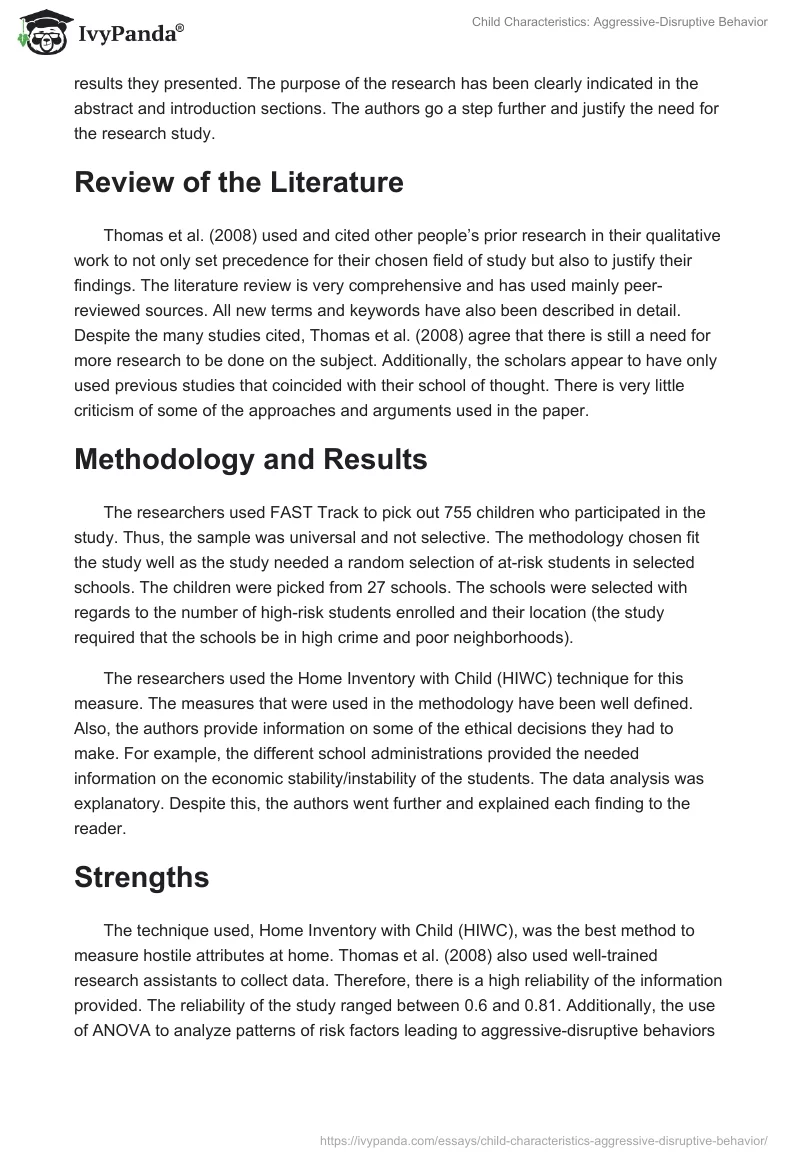Introduction
Several researchers, namely Thomas, Beirman, Thompson, and Powers (2008), conducted comprehensive research on “Double jeopardy: Child and school characteristics that predict aggressive-disruptive behavior in first grade.” The chosen study uses a qualitative research model. The primary objective of the research was to determine the relationship between different and combined child susceptibilities and the school context in early elementary.
The study went further to examine how that said relationship can lead to the development of forceful and violent student behavior in the first grade. The significance of the study has been well documented. The authors explain that the study will help better manage at-risk children. The authors expect that findings would help in modeling proper policies to ensure such children have an equal opportunity at education as other children.
The question, Hypothesis, and Purpose
The study chosen adheres to all requirements of scholarly research. The authors explain their hypothesis well, give reasons on the importance of the research, and present their findings fully. Thomas et al. (2008) came up with a hypothesis that high rates of forceful and violent behavior exhibited by children in early elementary classes went hand in hand with behavioral adjustment problems when said students reached first grade.
The behavioral adjustment problems were linked to both the pupil’s relationship and interaction with his/her teachers and also with his/her peers. The research is also engaging and uses scholarly citations to back up the different arguments presented. As stated, the research was conducted in two different schools in an attempt to validate the study hypothesis. The researchers were, therefore, able to validate the study and the results they presented. The purpose of the research has been clearly indicated in the abstract and introduction sections. The authors go a step further and justify the need for the research study.
Review of the Literature
Thomas et al. (2008) used and cited other people’s prior research in their qualitative work to not only set precedence for their chosen field of study but also to justify their findings. The literature review is very comprehensive and has used mainly peer-reviewed sources. All new terms and keywords have also been described in detail. Despite the many studies cited, Thomas et al. (2008) agree that there is still a need for more research to be done on the subject. Additionally, the scholars appear to have only used previous studies that coincided with their school of thought. There is very little criticism of some of the approaches and arguments used in the paper.
Methodology and Results
The researchers used FAST Track to pick out 755 children who participated in the study. Thus, the sample was universal and not selective. The methodology chosen fit the study well as the study needed a random selection of at-risk students in selected schools. The children were picked from 27 schools. The schools were selected with regards to the number of high-risk students enrolled and their location (the study required that the schools be in high crime and poor neighborhoods).
The researchers used the Home Inventory with Child (HIWC) technique for this measure. The measures that were used in the methodology have been well defined. Also, the authors provide information on some of the ethical decisions they had to make. For example, the different school administrations provided the needed information on the economic stability/instability of the students. The data analysis was explanatory. Despite this, the authors went further and explained each finding to the reader.
Strengths
The technique used, Home Inventory with Child (HIWC), was the best method to measure hostile attributes at home. Thomas et al. (2008) also used well-trained research assistants to collect data. Therefore, there is a high reliability of the information provided. The reliability of the study ranged between 0.6 and 0.81. Additionally, the use of ANOVA to analyze patterns of risk factors leading to aggressive-disruptive behaviors can be termed a strength. The ANOVA aided in determining the correlations of the risk factors associated with aggressive-disruptive factors easily and more efficiently.
Weaknesses
A significant weakness of the study is that some of the measures applied did not have a precise methodology. For example, the multilevel modeling, such as the linear model, is not well illustrated.
Reliability, Validity, and Limitations
The research can be described as reliable. The methodology used has high reliability because the participants did not change and the researchers were well trained. Additionally, the validity of the methodology is also assured as the school context was constant, and the inter-rater validity was high. Also, by setting alpha to be 0.05, the hypothesis was found to be true. However, one of the limitations of the study is that the researchers did not exercise caution when determining the causation and correlations in establishing purported risks and aggressive-disruptive behavior.
Use in Decision Making
Findings from the research study conducted by Thomas et al. (2008) can be used in the future to prevent elevating actions that can lead to the development of aggressive-disruptive behavior. Also, the findings realized can be used in developing behavioral policies that deal with at-risk children in vulnerable communities. Such decisions would, in turn, give at-risk children an equal opportunity to learning and succeeding in life.
Reference
Thomas, E. D., Beirman, K., Thompson, C., & Powers, C.J. (2008). Double jeopardy: Child and school characteristics that predict aggressive-disruptive behavior in first grade. School Psychology Review, 37(4), 516–532.


